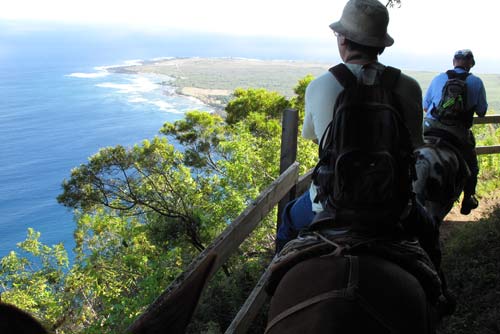OFF THE MAP
Words/Images: Noel Pietsch

Molokai Island Activities
There are few places in Hawaii as isolated as the remote peninsula of Kalaupapa on the island of Molokai. This U.S. National Park is cut off from Molokai by 1,700 foot cliffs, and surrounded on three sides by the Pacific Ocean. The Kalaupapa peninsula can only be reached by private charter plane, hiking the steep three-mile trail, or using a sure-footed Molokai Mule - a very scenic and adventurous way to visit Kalaupapa.
The Molokai Mule Ride was established in 1973 and inspired by the Grand Canyon Mule tours that take thousands of tourists into the canyon each year. Local businessmen liked the idea but were not sure if a mule could traverse the steep cliffs. They turned to the best “mule man” in the islands, Eldon “Buzzy” Sproat, to see if a mule tour to Kalaupapa was possible.
“I was living on Oahu, and who wants to live on Oahu,” say Buzzy, who was born and raised training mules on Big Island’s Parker Ranch. “So I flew over to Molokai and was the first guy to ever ride a mule down into Kalaupapa. I wasn’t even working for the company but when I rode the mule back up, proving it was possible to start a tour, the owner gave me an offer I could not refuse,” says Buzzy. Today Molokai Mule Ride is owned by Buzzy and his partner Roy Horner, and taking groups down into Kalaupapa six days a week on their 23 Molokai Mules.
“People always ask, what’s a mule Buzzy? And I tell them, if you think it’s a donkey, you’re half right. If you think it’s a horse, you’re half right,” says Buzzy. “But most importantly, these animals are extremely sure-footed and can be trusted to get you down and back up the trail safely.”
The tour begins at 8 in the morning. Guests are given a quick briefing, introduced to their mule for the day, then helped into the saddle to head out across the paved road towards the trail to Kalaupapa. Each mule has a distinct personality, and our guide Bobby, a Hawaiian who has been leading the mule tours for over 30-years, assures us that theses mules are so well trained that the riders can relax and enjoy the view. The trail begins by weaving in and out of a canopy of trees, past a bright green pasture and quickly to the start of the Kalaupapa trail.
“My favorite part of the ride is right at the top,” says Buzzy. “As soon as you turn the corner everybody is just taken aback because you are looking right down the cliff and out into the ocean and the Kalaupapa settlement… it’s just beautiful,” says Buzzy. The ride continues through 26 switchbacks and in and out of the cool shade of the Hawaiian forest. The views looking down the sea cliffs and into the village of Kalaupapa are spectacular and change with every few feet traveled, keeping riders entertained for the hour-long journey down the mountain. Upon reaching the magnificent black sand beach at the base of the cliffs, the mules traverse along the trail to a small corral where the ride ends and the tour of Kalaupapa begins.
Trading in the mules for an old yellow school bus, a driver takes the group on a tour of Kalaupapa, telling stories and teaching about the difficult challenges faced by the patients. From 1866 to 1969 people from Hawaii infected with Hansen’s Disease (Leprosy) were sent to live in isolation on Kalaupapa. Some were literally thrown from boats and had to swim to shore and struggle for survival. The tour travels through the town, including the local store, the one-pump gas station, the old hospital and the homes where 18 recovered Hansen’s disease patients still live.
The tour then travels from the settlement of Kalaupapa to Kalawao, stopping at the newly restored St. Philomena Catholic Church, the site of Father Damien’s grave. Set in front of a breathtaking backdrop of magnificent sea cliffs, the historic church and graveyard brings to life both the horrific tragedy of lives lost at Kalaupapa and the incredible compassion Father Damien had for these people. The tour concludes with a picnic lunch at beautiful Kalawao, the site of the first settlement on the peninsula, before heading back to meet the mules for the quick trip back up the trail. A day exploring Kalaupapa is like a day spent back in time. It is likely the least touristed tour in Hawaii, and leaves you feeling like you got the rare chance to see a piece of living history, a part of Hawaii that has remained relatively untouched since the 1870’s.
If you are making a quick trip over to Molokai just for the mule ride into Kalaupapa its best to plan to stay the night before the tour on Molokai. The last remaining hotel, Hotel Molokai, is just a quick 20 minute drive from the Mule Ride stables and a great option for a quick overnight trip. Located on the water just five minutes from downtown Kaunakakai, the hotel and its lively restaurant, with local music nightly, completes this true kama’aina experience.
Molokai Mule Ride: www.muleride.com
Kalaupapa National Park: www.nps.gov/kala/index.htm
Hotel Molokai: www.hotelmolokai.com

Click to Book go Mokulele Flight
c73a009e-4ad3-4e2c-b392-5cf609285c2c|3|5.0